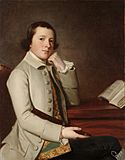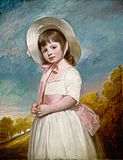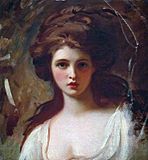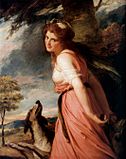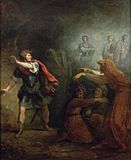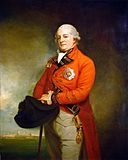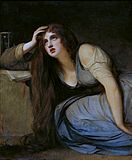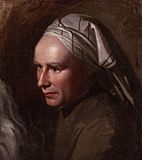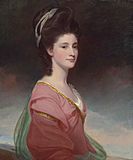George Romney (painter) facts for kids
Quick facts for kids
George Romney
|
|
|---|---|
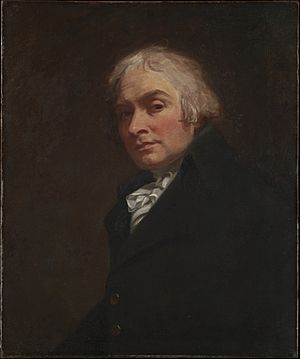
1795 self portrait
|
|
| Born | 26 December 1734 Dalton-in-Furness, Lancashire, England
|
| Died | 15 November 1802 (aged 67) Kendal, Westmorland, England
|
| Known for | Painting |
George Romney (26 December 1734 – 15 November 1802) was a famous English portrait painter. He was a very popular artist in his time. He painted many important people, including his artistic inspiration, Emma Hamilton. Emma Hamilton was also a friend of Lord Nelson.
Contents
Early Life and Art Training

George Romney was born in Beckside, Dalton-in-Furness, Lancashire. This area is now part of Cumbria. He was the third of eleven children. His father, John Romney, was a cabinet maker. George grew up in a cottage called High Cocken. He went to school in nearby Dendron.
George didn't enjoy school much. He left at age 11 to work for his father's business. He was naturally good at drawing and making things from wood. He even made violins, which he played throughout his life.
When he was 15, a local watchmaker, John Williamson, taught him art informally. His serious art studies began in 1755. At 21, he started a four-year apprenticeship in Kendal. He learned from Christopher Steele, a portrait artist. Steele had studied with a famous French artist named Carlo Vanloo. George's father paid for all his training costs.
In October 1756, Romney married Mary Abbot. He wasn't sure about this choice at first. They were separated right away when he had to go to York for work. After a year, George asked Steele to end his apprenticeship. Steele agreed. George was now a father and free to start his own painting career.
Romney's Art Career
Painting in Westmorland
In 1757, Romney went back to his wife and young son in Kendal. He worked as a painter of portraits, landscapes, and historical scenes. During this time, he became friends with Adam Walker, an inventor and writer. He also enjoyed music in his free time.
In March 1762, he moved away from his wife, son, and daughter. He went to London to find success. His daughter sadly died in 1763. He stayed in London until 1799, only visiting Cumbria a few times. He always kept in touch with his family and sent them money. But they never lived with him in London.
Success in London
In 1763, Romney entered his painting, The Death of General Wolfe, into a competition. This was held by the Royal Society of Arts. Friends of Romney said he won the second prize of 50 guineas. But this was later cut to 25 guineas for reasons that weren't very clear. Some say a famous artist named Sir Joshua Reynolds was behind this decision. This might be why the two artists didn't get along well after that.
The Royal Academy of Arts was formed in 1768. Romney was never asked to join it, even though he was urged to show his work there. He also never applied to join. This meant he missed out on support from the royal family and others connected to the court. People have wondered about his relationship with the Academy. But he usually kept his distance. He believed a good artist should succeed without being a member. His own career proved this belief. Only near the end of his life did he express a small regret about his views.
His first years in London were hard financially. In September 1764, he traveled to Paris for a few weeks. He went with his friend, lawyer Thomas Greene. He wanted to study the works of old masters. Traveling abroad was important for artists. There wasn't much great art to see in London at that time. In 1765, he won the second prize again in the Royal Society of Arts competition. In 1768, he met Richard Cumberland, a writer. Romney painted his portrait. Cumberland helped introduce him to important people who could help him. He also became friends with miniature painter Ozias Humphrey.
1769 was a very successful year for Romney. He showed a large portrait of Sir George Warren and his family. It was greatly admired. This helped him become very popular. In 1770, he started showing his work at the Chartered Society of Artists. This was instead of the rival "Free Society of Artists."
Studying in Italy
By 1772, Romney had enough money to travel to Italy. He went with Ozias Humphrey to study the great artists of the past, as he had always planned. He left in March, traveling through Europe. He went through Paris, Lyon, Marseilles, Nice, Genoa, Livorno, Florence, and Pisa. He arrived in Rome in June.
A special letter allowed him to meet the Pope, Clement XIV. The Pope let him put up a platform in the Vatican. This allowed him to study the famous paintings by Raphael. He spent 18 months in Rome. He made many studies and sketches of the great artworks there. He returned to London in July 1775. His journey back took him through Florence, Bologna, Venice, Parma, and Turin. He had been away for over two years.
Later Career and Return Home

When he returned in 1775, Romney moved to Cavendish Square. He lived in a house that used to belong to the famous portrait artist Francis Cotes. He owed a lot of money. This was partly his own debt, but also because he had to help his artistic but troubled brother, Peter, with his debts. However, the Duke of Richmond and his friends offered him painting jobs. This helped his luck change for the better. In 1776–77, he met William Hayley. They became lasting friends, and Romney painted portraits for him.
1782 was a very important year for Romney. He met Emma Hamilton (then called Emma Hart). She became his artistic inspiration. He painted more than 60 portraits of her. She posed in different ways, sometimes as historical or mythical figures. He also painted many other people of his time. This included fellow artist Mary Moser. In 1787, he painted a young lady named Miss Constable. This became one of his most charming works.
In 1797, Romney left his studio at 32 Cavendish Square. He had worked there for over twenty years. He moved to Holly Bush Hill in Hampstead. In Hampstead, Romney started some expensive building projects. He sold the house two years later. Romney's House is now a protected historic building. A blue plaque on the property remembers Romney.
In the summer of 1799, his health got very bad. After almost forty years away, Romney returned to his wife, Mary, in Kendal. She took care of him for the last two years of his life. He died in November 1802. He was buried in the churchyard of St. Mary's Parish Church, Dalton-in-Furness.
George Romney is related to American politicians George W. Romney (1907–1995) and Mitt Romney (born 1947). Their ancestor, Miles Romney, was George Romney's first cousin once removed.
Public Collections of Works
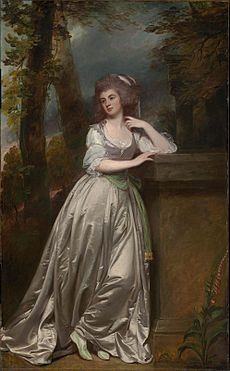
Romney's paintings are shown in many museums and art galleries. You can find them in the UK, North America, and other places:
- UK and Ireland
- Abbot Hall Art Gallery (Kendal); Kendal Town Hall (Kendal); Ashmolean Museum (University of Oxford); Courtauld Institute of Art (London); Dorset County Museum (Dorchester); Dulwich Picture Gallery (London); National Portrait Gallery, London; National Maritime Museum (London); Tate Gallery (London); Wallace Collection (London); Falmouth Art Gallery; Fitzwilliam Museum (University of Cambridge); Dalton Castle; Manchester City Art Gallery; National Museum Cardiff; National Museums Liverpool; New Art Gallery (Walsall); National Galleries of Scotland; Somerville College, Oxford; Crawford Municipal Art Gallery (Ireland); Waddesdon Manor (Buckinghamshire).
- United States and Canada
- Ackland Art Museum (University of North Carolina); Art Gallery of the University of Rochester (New York); Art Institute of Chicago; Beaverbrook Art Gallery (New Brunswick); Blanton Museum of Art (University of Texas at Austin); Brigham Young University Museum of Art (Utah); Carnegie Museum of Art (Pittsburgh); Dallas Museum of Art; Detroit Institute of Arts; the Fine Arts Museums of San Francisco, Robert Hull Fleming Museum (University of Vermont); Frick Collection (New York City); Forsyth County Public Library Central Branch, Winston-Salem, North Carolina; the Getty Museum (Los Angeles); Harvard University Art Museums; Honolulu Museum of Art; Huntington Library (California); the Kimbell Art Museum (Fort Worth, Texas); the Los Angeles County Museum of Art; Metropolitan Museum of Art (New York City); Museum of Fine Arts, Houston (Texas); Museum of Fine Arts, Boston; National Gallery of Art (Washington D.C.); Norton Simon Museum (Pasadena, California); Owens Art Gallery (Mount Allison University, Sackville, NB); Philadelphia Museum of Art; Stan Hywet Hall and Gardens (Ohio); Wadsworth Atheneum (Hartford, Connecticut); Phoenix Art Museum (Phoenix, Arizona); National Gallery of Canada; Folger Shakespeare Library (Washington, D.C.).
- Elsewhere
- Dunedin Public Art Gallery (New Zealand); Hermitage Museum (St. Petersburg, Russia), Louvre (Paris, France); Musée des beaux-arts (Pau, France), National Gallery of Victoria (Australia), MASP (Brazil).
Gallery
-
Macbeth and the witches, 1785
-
John Henderson as Macbeth, c. 1787
-
Major General Sir Archibald Campbell K.B. of Inverneill, 1790–1792
See also
- English school of painting


